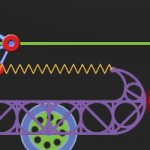Presumably the position where you are going to place the platform is going to depend on the speed and height of the spuCraft as it passes through one or more light gates. You pilot does not know the height and speed of the spuCraft until it passes through the light gate. Therefore you shouldn’t switch to the new input script until it has passed through the light gate(s).
If you switch to the input script too early, it will start positioning the platform based on bad information. Then, when you get good information as the spuCraft passes through the light gate, the platform might be too far away to get to the right location in time.
Related question: Do I need an automatic switch?
